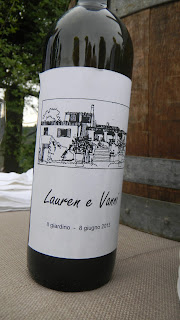Tuscany is infamous for good food, and I've had some incredible meals during my stay there. The highlights for me have included fresh porcini salad with shaved parmesan, Tuscan fagioli bianchi (white beans) slow-cooked with sausage, pappa pomodoro (Florentine tomato-bread soup), and the best homemade lasagna I've ever had (made by la nonna - grandmother - of course.)
Dining in Tuscany is a slow experience, to enjoy the food and surroundings, and here were some wonderful meals:
A light evening supper of salumi antipasto (selection of meat and cheese), olive and tuna crostini, and arugula salad with salami, served with sparkling white wine. We ate outside on the terrace with stunning views of the Tuscan countryside at sunset.
Then there was the family feasting on weekends. We had a wonderful Saturday lunch in the Tuscan countryside, with family and long-time friends at their rustic country house in the hills. We dined outside under the cherry trees:
Next came the meat. First came the cacciagione - game meat - roasted birds (small wild birds similar to pidgeon or squab), cooked until crispy, their bones so thin you could eat them like crunchy chips. Then came slow-cooked fowl with sage, and tagliata, juicy steak cut into slides. Here's the cottage cucina (kitchen) where she cooked it all:
The contorni (side dishes) followed: chickpeas served with fresh olive oil they make on the property, salad of mixed greens dressed simply, and homemade bread made with walnuts. For dolci (dessert) we had homemade pannacotta drizzled with melted dark chocolate, and biscotti with Vin Santo sweet wine and grappa to finish.
This afternoon lunch took hours, to savor each dish and enjoy your fill of each course, and share good wine and conversation. No wonder Italians have espresso after meals - after eating so much food, you could easily fall asleep! It was an epic meal.
Dining in Tuscany is a slow experience, to enjoy the food and surroundings, and here were some wonderful meals:
A light evening supper of salumi antipasto (selection of meat and cheese), olive and tuna crostini, and arugula salad with salami, served with sparkling white wine. We ate outside on the terrace with stunning views of the Tuscan countryside at sunset.
Then there was the family feasting on weekends. We had a wonderful Saturday lunch in the Tuscan countryside, with family and long-time friends at their rustic country house in the hills. We dined outside under the cherry trees:
The antipasti was fresh melon with prosciutto, finocchiona (fennel sausage), roasted peppers, and an assortment of cheese. They used the table in the house to stage courses, all the plates prepped:
Next came the meat. First came the cacciagione - game meat - roasted birds (small wild birds similar to pidgeon or squab), cooked until crispy, their bones so thin you could eat them like crunchy chips. Then came slow-cooked fowl with sage, and tagliata, juicy steak cut into slides. Here's the cottage cucina (kitchen) where she cooked it all:
The contorni (side dishes) followed: chickpeas served with fresh olive oil they make on the property, salad of mixed greens dressed simply, and homemade bread made with walnuts. For dolci (dessert) we had homemade pannacotta drizzled with melted dark chocolate, and biscotti with Vin Santo sweet wine and grappa to finish.
This afternoon lunch took hours, to savor each dish and enjoy your fill of each course, and share good wine and conversation. No wonder Italians have espresso after meals - after eating so much food, you could easily fall asleep! It was an epic meal.






































